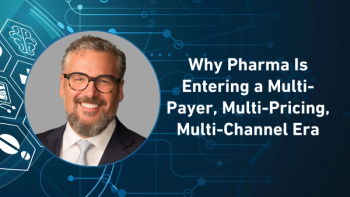
- Pharmaceutical Commerce - May/June 2016
Changing the payment paradigm
Policymakers look at alternative payment models in oncology
Oncology stands out in the debate over how drugs are priced and paid for in the US, although oncolytics are certainly not the only drugs getting this attention. Nevertheless, the cancer care community—oncologists and health administrators—have issued reports and recommendations to address the reimbursement issue. The latest is the American Assn. for Cancer Research (AACR), which sponsored (along with the Personalized Medicine Coalition and Feinstein Kean Healthcare) a study, “The impact of alternative payment models on oncology innovation and patient care,” presented at this spring’s AACR meeting (April 17–21; New Orleans, LA). The three organizations constitute AACR’s “Turning the Tide Against Cancer” initiative.
Fig. 1. Released in February, the Harris Poll measure of positive “relationship quotient” shows pharma as one of the few industry sectors on a steady decline. Credit: Harris[/caption]
“Cancer care has featured prominently in the national conversation about value-based healthcare, which is not surprising given the health and economic burdens of cancer in the United States, as well as the unique needs of cancer patients,” the authors wrote in the study. The alternative payment models (APMs) within the scope of the study include accountable care organizations, episode-based payment models and oncology-centered medical homes.
The initiative sponsors held a roundtable involving physicians, researchers, advocates, representatives of insurers and pharmaceutical companies, and policymakers, and out of those discussions, five policy recommendations arose:
- APMs should keep pace with rapidly emerging science by incentivizing the adoption of innovative medicines and technologies that have the potential to improve patient outcomes and make healthcare more efficient.
- APMs should include mechanisms to encourage patient participation as appropriate in clinical trials, as well as ongoing post-market clinical research.
- Clinical pathways should be transparent and evidence-based, and updated regularly to reflect current scientific evidence and clinical advances within the overall continuum of care.
- When providers and patients are making treatment decisions, patients should be given a clear, comprehensive picture of their treatment options, including cost information that is tailored to the specific patient's insurance coverage and treatment plan.
- APMs should require that clinical data be aggregated and integrated into providers' workflows via electronic health records in order to support learning healthcare systems. Providers should have access to data that will support their shared decisionmaking with patients. Similarly, patients should have access to research results collected through a learning healthcare system.
The Centers for Medicare and Medicaid Services (CMS) is getting into the alternative-payment mode itself. In March, it issued a draft proposal to set up an experimental program within Medicare Part B to address the higher cost of newer, branded pharmaceuticals. Six methods are proposed:
- Improving incentives for best clinical care. Physicians often can choose among several drugs to treat a patient, and the current Medicare Part B drug payment methodology can penalize doctors for selecting lower-cost drugs, even when these drugs are as good or better for patients based on the evidence. Today, Medicare Part B generally pays physicians and hospital outpatient departments the average sales price of a drug, plus a 6% add-on. The proposed model would test whether changing the add-on payment to 2.5% plus a flat fee payment of $16.80 per drug per day changes prescribing incentives and leads to improved quality and value. The proposed change to the add-on payment is budget neutral.
- Discounting or eliminating patient cost-sharing. Patients are often required to pay for a portion of their care through cost-sharing. This proposed test would decrease or eliminate cost-sharing to improve beneficiaries’ access and appropriate use of effective drugs.
- Feedback on prescribing patterns and online decision support tools. This proposed test would create evidence-based clinical decision support tools as a resource for providers and suppliers focused on safe and appropriate use for selected drugs and indications. Examples could include best practices in prescribing or information on a clinician’s prescribing patterns relative to geographic and national trends.
- Indications-based pricing. This proposed test would vary the payment for a drug based on its clinical effectiveness for different indications. For example, a medication might be used to treat one condition with high levels of success but an unrelated condition with less effectiveness, or for a longer duration of time. The goal is to pay for what works for patients.
- Reference pricing. This proposed model would test the practice of setting a standard payment rate—a benchmark—for a group of therapeutically similar drug products.
- Risk-sharing agreements based on outcomes. This proposed test would allow CMS to enter into voluntary agreements with drug manufacturers to link patient outcomes with price adjustments.
One of the primary problems the changes would address is the negative incentive doctors have today for prescribing lower-cost drugs: because the current reimbursement is tied to ASP+6%, a higher-cost drug will generate more income to the physicians than a lower-cost one. Other proposals would bundle higher-cost and lower-cost drugs of the same therapeutic class, potentially making the higher-cost purchase less attractive. The risk-sharing agreement approach picks up on a practice that is more common in the EU, but which has been tried selectively in the US. And, as CMS notes, “Commercial health plans, pharmacy benefit managers, hospitals, and other entities that manage health benefits and drug utilization successfully employ an array of tools including value-based pricing and feedback on prescribing patterns to improve the value of drug payments.” CMS would like to try some of these reimbursement mechanisms itself.
Reaction was swift in Washington: “[U]pon initial review, we are gravely concerned that the model threatens to disrupt the successful reimbursement framework for drugs covered under the Medicare Part B program,” said BIO. “Proposing sweeping changes to Medicare Part B drug reimbursement without thoughtful consideration and stakeholder input is not the right approach and puts Medicare patients who rely on these medicines at risk,” said PhRMA. A joint statement from Republican leaders of House and Senate committees involved with healthcare oversight asserted that “Yesterday's announcement marks another troubling example of unelected bureaucrats making decisions behind closed doors that impact the American people and their healthcare. This decision was made with a complete lack of transparency and clear disregard for the people and stakeholders who will be impacted the most."
The Community Oncology Alliance (COA), a public interest group representing those practitioners, was flat-out oppositional: “COA notes that it is actively pursuing every legal, legislative and related option on behalf of members to stop the CMS Medicare Part B experiment,” it asserted. COA also stated directly what other critics have implied: that throttling specialty pharmaceutical prices will harm the practice of community oncology—generally, nonaffiliated oncologists treating individual patients—which it maintains can provide cancer care at a lower cost than oncology centers affiliated with hospital systems. (It’s not clear whether the proposed changes would affect community oncologists better or worse than the oncologists affiliated with health systems, yet that is what COA foresees.)
If CMS goes forward after the 60-day comment period ends, it expects to set up the test programs in the fall, and to have value-based purchasing begin testing no sooner than next January, and for the program to be “fully operational” around late 2018. Gearing all this up in the middle of an election year is sure to be another factor that CMS will have to overcome.
Declining approval
Alternative payment models and the like involve the insurance industry, health systems and providers as well as the pharma industry itself. But the intensifying debate over drug pricing (which wasn’t helped at all by the Congressional hearings involving Valeant and Turing Pharma last fall) shine an uncomfortable spotlight on the pharma industry and its pricing practices.
In this context, it’s worth paying attention to public-sentiment surveys, such as those run by the Harris polling organization. Earlier this year, it released its “Relationship Quotient” survey, which polls general-public impressions of various companies and industries (Fig. 1). Unlike every other industry sector surveyed, the pharma industry’s “positive mentions” have declined continuously since 2014. In this survey, financial services companies nosed ahead of pharma in public approval; at this point, the only sectors with less appeal than pharma are government and the tobacco industry.
The pharma industry has gone through tough times before, and until 2014, its reputation was on something of an upward slope. And it’s true that drug prices are not the sole reason for this industry’s reputation, good or bad. Nevertheless, the pointers are all going in the wrong direction for the pharma industry to keep its position regarding pricing, import exclusivity and public investment going forward.
Articles in this issue
over 9 years ago
FDA looks to industry for help in DSCSA complianceover 9 years ago
Clinical cold chain vendors go into a deep freezeover 9 years ago
Oncology: a new era in therapies; same cost concernsover 9 years ago
Brand enhancement and safety with unit-dose packagingover 9 years ago
Managing supply chains from the cloudover 9 years ago
Specialty pharmacy dynamicsNewsletter
Stay ahead in the life sciences industry with Pharmaceutical Commerce, the latest news, trends, and strategies in drug distribution, commercialization, and market access.



